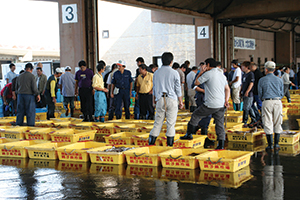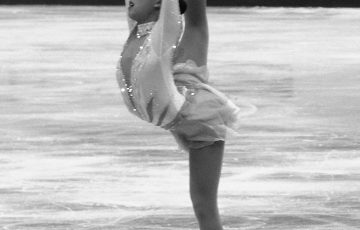 Saitama has nice little mountains and pretty rivers, but not having beachfront property seriously diminishes the prefecture’s status on the recreational scale. Kanagawa is famous for its beaches and rolling hills. But fame has a hefty price in terms of fighting the weekend crowds. For down-to-earth fun, Chiba is the place to go.
Saitama has nice little mountains and pretty rivers, but not having beachfront property seriously diminishes the prefecture’s status on the recreational scale. Kanagawa is famous for its beaches and rolling hills. But fame has a hefty price in terms of fighting the weekend crowds. For down-to-earth fun, Chiba is the place to go.
CHIBA IN GREEN
I might be the only person who appreciates the greenery of Chiba during the ride between Tokyo and Narita Airport. Though the rice paddies have all but disappeared, the tree-lined roads are easy on the eyes. Rural Chiba is indeed a green place. Chiba is also home to three forest adventure parks catering to varying ages.
Tarzania is a zipline adventure park for adults and families. Ziplines are a new form of outdoors entertainment. A zipline consists of a free-moving pulley attached to a steel cable. Riders are hooked onto the pulley by a harness and glide from a starting platform to a lower point using only the force of gravity. First introduced as a means of accessing remote areas such as rainforest canopies, they are now a popular recreational activity in Europe and North America.
At Tarzania, there are two sets of courses. The first is called the Discovery Course and is catered to families, though children must be over 110 cm tall to participate. To try the adult-oriented Adventure Course, you have to be over 140 cm. This course involves challenges such as climbing rope ladders and traversing across various obstacles as well. There are six zip cord rides included. Some are more scenic and others provide a thrilling experience. You don’t have to be athletic but being in decent shape helps climbing rope ladders and crawling through tunnels. In many parts of the world, zipline adventure parks are used for corporate team building or motivation workshops where people bond by encouraging each other to try new challenges.
Tarzania is on the same property as Seimei no Mori, a world-class training facility that includes an Olympic-size swimming pool, a 400-meter track course and tennis courts. The sports facility here offers drop-in swimming and aerobics exercises. There is also a golf course and the Gary Player Golf Academy nearby. If you want to turn a day trip into a weekend excursion, there is also a hotel and cottages for larger groups on the premises. There are clearly plenty of activities here to keep people busy and fit.
Near Narita airport is the Undo no Mori Park, a family-oriented recreational park. In Japan, outdoor obstacle courses called “field athletics” are very popular. This park is aimed at kids aged 6-15, but parents won’t get bored here. In mini-golf, there are score cards where points are given for each successfully completed obstacle. The highlight of the park is the water hazard area where people are certain to get wet, so bring a change of clothes. This is a great outing for active families.
 Andersen Park in Funabashi is a lovely park that offers both outdoor fun and cultural activities for all ages. If you’ve been to Showa Kinen Park or Koganei Park, this park is comparable. In terms of space, it is smaller but offers plenty of activities.
Andersen Park in Funabashi is a lovely park that offers both outdoor fun and cultural activities for all ages. If you’ve been to Showa Kinen Park or Koganei Park, this park is comparable. In terms of space, it is smaller but offers plenty of activities.
Named after Hans Christian Andersen, the park aims to create a fairy tale atmosphere. On the weekends, it is usually packed with families, but the park is also a popular date spot for couples. Paddling a rowboat around the manmade pond or renting bicycles to cycle around are all well and good, but they are standard activities in other parks. It is only here, though, that you can create your original souvenirs in the park’s craft zone. Whether it is designing your own candy dish from clay or tie-dying handkerchiefs, there are plenty of choices for the nimble fingered grown-up.
Senior local residents like to take advantage of the park on the weekdays to enjoy the scenery and try out the various crafts ateliers. Indeed, the craft zone is more than child’s play. On any given month, there are workshops on glassmaking, woodwork, and weaving. Funabashi Andersen Park offers a yearly pass to frequent visitors and free admissions to seniors over 65. One woman in her sixties says she tries to come at least once a month. “There are beautiful flowers planted here all year round, so it is a wonderful place for a stroll, but I mostly come for the crafts. I have learned how to use a pottery wheel here and have lovely handmade Christmas ornaments for my tree. Community center courses often fill up fast and private lessons can be expensive. People working at the craft zone are young and cheerful. This place is truly a hidden treasure for senior citizens.”
 CHIBA IN BLUE
CHIBA IN BLUE
Choshi is a fishing village perched on the most eastern point of Chiba that looks out onto the Pacific Ocean. It is about two hours away from Tokyo by train on the main Sobu Line or by car, but this quaint seaside town is definitely worth a visit.
To enjoy Choshi properly, it is best to leave as early as possible in order to make it to the fish market at the harbor when it is bustling with business. There are three separate markets and the first deals with large-sized fish such as tuna, octopus and sharks. This market peaks at 7 am, and by 9 am it is already shutting down. For a day trip, it may be a challenge to catch the action here. However, Choshi specializes in smaller, locally caught seafood so the heart of the Choshi fish auction is the second market where medium-size seafood are sold. Business here starts when the first market closes and work continues until almost noon.
The market is open-air but has a roof. Hundreds of yellow trays are lined up in neat rows here. Registered buyers scrutinize the fish, then scribble numbers on pieces of bidding paper between puffs on their cigarettes. The market workers then select the winner by sorting out the soggy bits of papers. Unlike Tsukiji Market’s boisterous bidding wars, the auction at Choshi is silent. What’s nice about this market is how friendly the workers are. Due to the influx of tourists, Tsukiji during prime hours can be downright hostile to visitors, but at Choshi people are more than happy to show you their catch and have their pictures taken.
Looking at all that seafood usually works up an appetite. Many tourists end up at the Port Tower, a Choshi landmark, for a meal and some souvenirs. But the better bet for good local seafood is to find a place in town. Near Choshi Station, there are many small Japanese restaurants featuring local specialties. I had a bowl of marinated raw sunfish with rice. An unusual catch, this special of the day was good only as novelty food. I now know sunfish tastes similar to the red part of tuna but more sinewy. The anago sushi, though, was firm and meaty, and the local fish sashimi plate was also delicious.
A short drive from Choshi city takes you to Inuboshisaki Lighthouse, which marks the most eastern point in all of Japan. The lighthouse officially stopped operations in 2008 and is currently open as a tourist attraction. You can climb to the top of the bright white tower and look out right onto the Pacific Ocean. Guidebooks claim that looking out onto the horizon from that angle makes the earth look round, but on the misty day we visited, it looked flat. However, being that high up and close to the water made us feel we were actually out at sea.
Toriake-ura Beach is a long sandy beach adjacent to the lighthouse. Even on a sunny weekend in September, there are only a handful of surfers and a few locals walking big dogs. Watching kids frolic and splash around in the white-capped waves, it becomes apparent that this is a world away from Tokyo’s maddening crowds. To wash off sand and salt water, you can take a hot spring bath at the Keisei Hotel across the street from the beach.
Choshi is an ideal day trip with a bit of everything: cultural interest, spectacular scenery, fun on the beach, hot spring relaxation and fresh seafood. Get an early start to make the most of the day out.
Inland Chiba is green, and by the sea it is blue. Depending on your preference, Chiba can color your weekend any way you want it.
Story by Carol Hui
From J SELECT Magazine, April 2010















Recent Comments